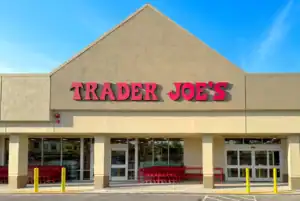
iStock.com/Sundry Photography
July 11, 2024
What Impact Will Walmart’s New Technology Have on the Grocery Industry?
Walmart is ramping up its grocery network by constructing five new high-tech perishable distribution centers in California, Illinois, New Jersey, South Carolina, and Texas.
These developments alone will be responsible for creating approximately 2,000 new jobs and bolstering supply chain capabilities. The retailer is also expanding automation at four existing facilities in Minnesota, North Carolina, Indiana, and Tennessee, adding at least 500,000 square feet of automation per site. This improved automation is designed to handle perishable items for the company.
Additionally, Walmart is retrofitting facilities with advanced technology to match its more modernized distribution centers. Specifically, the company announced in its press release that it intends to upgrade its outdated facility in Winter Haven, Florida, with plans to approach it similar to its upgraded facility in Brooksville, Florida. This technological investment aims to significantly boost storage capacity and processing speed, ensuring better fulfillment of increasing customer demand.
Moreover, Walmart emphasized the transformative impact of technology on job roles, shifting physically demanding tasks to roles where associates operate and maintain high-tech systems. Former manual laborers might now work as automation equipment operators, control center operators, technicians, or managers, reporting greater job satisfaction and often higher pay.
In its announcement, Walmart claimed to be “the largest grocery retailer in the U.S., with our grocery network supporting over 4,600 stores with a massive pickup and delivery business that continues to grow as customers seek the convenience and value we offer.”
In order for it to maintain that self-proclaimed title and to have an edge over the competition, Walmart recognized that meeting the demands of its customers is a top priority. Getting fresh perishable items to consumers is one of the key ways to do that. With its upgraded technology, the company outlined its newly refined process:
- Cases arrive from farmers and suppliers and are removed from their pallets and inspected.
- Everything is then moved into a temperature-controlled environment and kept in an 80-foot-tall automated storage system.
- As soon as it’s time to put together a store order, the system begins retrieving necessary cases and assembling pallets for stores, separated based on department to make them easier to unload.
- The most fragile items (such as fruit and eggs) are prioritized to be placed on the very top of pallets.
- Finally, the pallets are completely packaged and then put inside delivery trucks to be sent out.
As Walmart upgrades its grocery supply chain, other grocery supermarkets must adapt and find their edge in order to compete and stay afloat. Almost always the lowest-price leader, Walmart has the ability and resources to offer low prices on almost anything at any time. But prices can only fall so low before most items and retailers level out the playing field.
Therefore, Walmart has decided to focus on its delivery business, especially with Amazon announcing its new grocery subscription and delivery service that’s being rolled out for Prime members. This service allows Amazon to compete in the grocery sector by offering low prices and fast delivery. Another major retailer, Kroger, has been busy attempting to finalize a merger with Albertsons.
Walmart’s success has always impacted local communities in many ways. As Walmart continues to up its grocery game, regional supermarket retailers may also be strained and will need to find ways to remain relevant.
Discussion Questions
How will Walmart’s advancements in automation and supply chain technology reshape the competitive landscape of retail grocery, and what strategies might smaller regional supermarkets adopt to stay relevant?
With Walmart’s shift to high-tech systems transforming job roles, what are the broader implications for the retail workforce in terms of job satisfaction, skill requirements, and employment opportunities?
As Walmart and Amazon enhance delivery services and integrate advanced technologies, how might traditional brick-and-mortar grocery shopping be affected?
Poll
BrainTrust
David Spear
President, Retail, OrderlyMeds
Neil Saunders
Managing Director, GlobalData
Jeff Hall
President, Second To None
Recent Discussions







Walmart’s play in automating distribution centers is the ultimate direction of travel of the entire grocery sector. While automation comes with an up-front capital cost, this is repaid via greater efficiencies, improved volume handling, and reduced labor expenses. In a margin thin sector, like grocery, these incremental gains are critical for profitability; especially so at a time when ecommerce is growing and depleting margins. The interesting test case here will be to see the pay-off of retrofitting existing centers versus opening new ones. In any case, this move is one that will help maintain Walmart’s dominance in grocery.
Incrementally. That may seem like a cop-out answer, but in reality it just empahsizes that the important changes in retail aren’t flashy, like drones, but the continuous refinement of existing technology.
No cop-out, Craig. That is the way Sam Walton thought.
Modernize, modernize, modernize. Grocery companies that grow complacent won’t have a chance against the behemoths that are embracing new technologies at every turn.
Walmart knows what it’s doing. The company showed that during the pandemic and continue to move forward. Grocery is a traffic driver, though I do think it’s a separate trip from various sundries. It lets people se the store at least.
I confess, I’ve become a fan
Walmart’s significant and expansive investments in technology, along with those by Kroger/Albertson’s, Publix and Amazon will result in these operators increasing their market share while widening the gap between those who succeed and those who will chronically struggle.
We will witness continued consolidation in this sector, given the required capital investments, as well as some brands not remaining sustainable.
Walmart’s advancements in automation and supply chain technology will help Walmart a lot, but it will be quite a while before it has any impact on the industry, overall.
The retail industry doesn’t concern itself with keeping up with, or imitating, Walmart’s advancements, technical, or otherwise, as much as you might think. Walmart is Walmart, and the industry regards them mostly as a price competitor, but not much else.
Most of the industry concedes the price advantage to Walmart, but Walmart has little to do, directly or indirectly, with how other retails run their businesses.
Even Target pays little attention to what Walmart is doing. I know this all sounds crazy, but its true. – Db
Wal-Mart has earned its position by investing in and setting the standard in supply chain operations, boosting productivity in their insanely high volume business. Given this, their ongoing focus in new technology, new DC’s, and improved operations is really nothing new, but rather Wal-Mart continuing to push the envelope. Other grocery retailers also continue to invest in improved operations and new technology, just not the same scale as Wal-Mart.
Walmart is always tweaking and trialing, which is why it continually pushes the industry to adapt to new ways of working, new technologies and new models. This is just another day in the life of Walmart, who repeatedly invests in its business so that it can maintain its brand promise of EDLP. Naturally, competitors will have to keep pace or face negative consequences. This is good for all consumers because free market dynamics provide us with more conveniences, more choices, and improved experiences.
Walmart’s strategy to continue to automate its distribution centers will help it support its brand promise of “Every Day Low Price.” Optimizing the efficiency and reducing the costs of all processes helps Walmart be the leader in gocery prices. This is another example of how Walmart dominates the grocery industry. Competitors need to find creative ways that they can optimize their processes or differenitate based on service.
From the beginning, Sam Walton’s philosophy was that the foundation of Walmart’s successful supply chain strategy is an efficient supply chain management system, clearly defined inventory types, an intelligent distribution system, and streamlined supply chain operations. At Walmart, the EDLP philosophy starts with the distribution system and its costs. These improvements continue more than 50 years later.
Traditional retailers will have to step up. In many cases, they will not have the resources to compete on the distribution side. Even Target and Kroger will be playing catch-up. This is nothing new. They have been playing catch-up to Walmart forever.
Planned, incremental, upgrades, additions and implementations are key to better managing costs in any business. Logistics are so far behind in this that any upgrades will help, but the other true grocery retailers (Kroger, Safeway, etc.) are also doing this and more. It is important to note that Walmart is doing this, not creating these logistical mechanisms and improvements. Being the biggest does not always mean that you are the best, as any regular consumer will attest to.
Walmart’s investments will ultimately reset the grocery playing field. While I applaud every effort to build efficiencies and streamline processes to help with margins, I see the bigger play in the vertical delivery services. For brands like Walmart and Amazon to fulfill consumer direct orders withouth the need for third party vendors like grub hub or instacart, they will have a price advantage and own the total customer experience.
By making fresh food available faster, Walmart will entice shoppers to visit more frequently to retain its grocery leadership and loyalty. Employees also win, as these innovations help to protect worker safety.
Walmart will retain the top position as leading in supply chain for food products. This investment will likely provide additional efficiencies and result in a larger competitive gap. It is difficult for other grocery retailers to match what Walmart does on technology investments. Instead, it may make more sense to be fast followers and invest in things that are proven to work and will best benefit their business and customers.
One thing that I was interested in the article that was not present, was the impact on perishables shrink. Assuming that they reduce the time in the warehouse and get the products to the stores faster, there could be potentially fresher/better produce and less waste which could provide Walmart another advantage.
The sheer scale of the investment and the high level of automation necessitates high volume both on the sales side, but also on the supply side. And that forces Walmart to deal ever more with the handful of agribusiness megacorps who can supply those volumes in the formatting this technology requires. There’s an upper limit to this practice, as over-corporatization of farming leaves us less secure in food safety, disease outbreaks, genetic diversity of our crops, and worker protections, and degrade local food traditions. I agree with Brian’s thought that smaller suppliers and retailers may ultimately do better by seeing which technologies and systems spin out from this action that are affordable & better enable direct distribution at the regional level.
WM is creating higher skill job categories while continuing to drive consumer enhancing efficiencies. Kroger, Publix and others will have a hard time keeping up. The one “achilles heel” if you will is the WalMart brand does not enhance the sale of groceries like it does other categories-however they have been slowly polishing that up and I believe it will become less of an issue over time.
This makes it imperative the regional supermarkets do everything they can to leverage technology while also doing what they do best. Walmart may have a strong price image and in hundreds of studies I’ve done, that’s about it, but given their scale that’s plenty of business.
This application of automation should extend the life of perishables for Walmart. Perishables like to be kept at the proper temperature and dislike being handled. Walmart handling perishables with automation addresses both issues.
As I read the process, I realized this is how it should be. Maybe some technology makes implementing it better, but it still seems to be common sense. That’s not to take away anything from the Walmart process. Instead, it emphasizes that continuously tweaking a system that seems to be working is a good thing, and little changes can make small differences, but overtime will make big differences.
Walmart’s advancements in automation and supply chain technology will make it even harder for smaller regional supermarkets to compete. These supermarkets will need to focus on local produce, personalized service, and community engagement to stay relevant.
Walmart’s shift to high-tech systems will likely improve job satisfaction and pay, but it will also require workers to learn new skills, potentially limiting opportunities for those, who are less tech-savvy.
As Walmart and Amazon enhance delivery services, traditional brick-and-mortar grocery shopping may decline, with more consumers preferring the convenience and speed of online shopping. This will push smaller stores to innovate and find niche markets to survive.
This will have a big impact on the grocery industry but it will take a while for others to be able to adapt this technology, those without the deep pockets Walmart has will take a while before the technology becomes cheap enough and widely available enough to adapt, this but move will lead the way. It will also it likely will also make it harder for other big players to keep up. Walmart is smart to invest in grocery technology, while slim margins, this are drives up frequency and share of wallet. This is an area to watch.